![[Land List Home]](pics/nav-home.gif)
![[Camera List]](pics/nav-dcam.gif)
![[Accessory List]](pics/nav-acc.gif)
![[Film List]](pics/nav-film.gif)
![[FAQ]](pics/nav-faq-inv.gif)
![[More!]](pics/nav-more.gif)




























![[Land List Home]](pics/nav-home.gif)
![[Camera List]](pics/nav-dcam.gif)
![[Accessory List]](pics/nav-acc.gif)
![[Film List]](pics/nav-film.gif)
![[FAQ]](pics/nav-faq-inv.gif)
![[More!]](pics/nav-more.gif)




























After reading about the alternatives for 40-series film that I
described, some Highlander-owners evidently felt left out. One
of them, John Pouncey, sent me a description of his way of using
conventional 120 film in his model 80B Land camera. I've put
together the following instructions based on his idea. [I haven't
actually tried it myself yet, but John reports good results with
his first attempt, and I can't see any good reason why it wouldn't
work.]
Keep in mind that, as with the other "alternate film" techniques described on this site, this is really intended for the photographic hobbyist who merely wants to try to take a picture or two with his or her old camera rather than as a serious everyday solution to the problem of a non-existent film supply.
Also, since this technique uses conventional (non-instant) film, it will probably only be useful for those willing and able to process the film themselves.
If you think that the above statements still describe you, then read on!
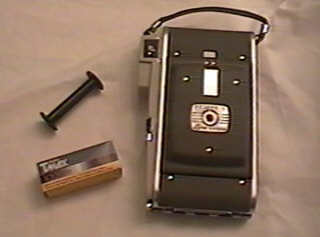
You'll need an 80-series or J33 Polaroid camera (of course), a roll of your favorite film in 120 size, and an empty 120 film spool. [If you use 120 film on a regular basis, you probably already have a bunch of empty spools lying around. If you've never used 120 before, try asking at your local full-service camera store or professional photofinishing lab; my guess is that they'd likely be happy to give you one. If all else fails, you could use a wood dowel or pencil cut to size or something of that sort, or even a plastic spool from a roll of 30-series Polaroid film as originally used in your camera.] Incidently, the camera shown in these illustrations is a model 80A.
In addition, you will also need a photographic changing bag or darkroom in order to load (and advance) the film. (a closet or bathroom that can be made completely dark will also work fine)
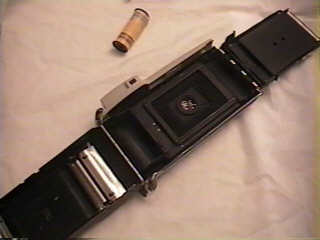
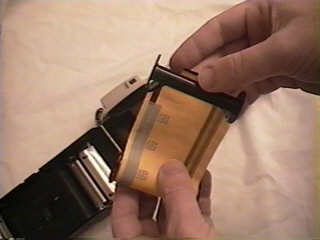
Now, in total darkness (i.e. in your darkroom or using your changing bag), continue to feed the film onto the take-up spool until you feel the point where the start of the film emulsion is taped to the paper backing. With the end of the film at the point where it is just on the take-up spool, place the take-up spool in the well to the right of the film plane, and place the source spool in the film well at the left of the film plane. Keep as much tension between the two rolls as you can.
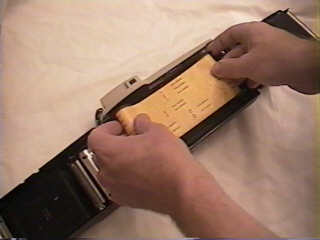
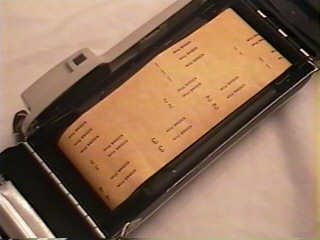
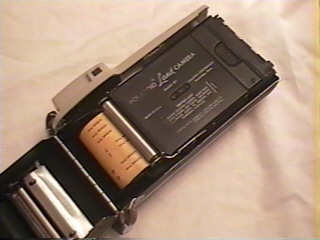
Now close the back of the camera, and your camera is loaded and ready
for taking a picture!
You can find a chart of shutter speeds/apertures for 80-series cameras
on the miscellaneous data page.
After you take a picture, you'll have to go back to your darkroom (or changing bag) to advance the film. So, in total darkness open the back of the camera again. Lift the two spools straight out of the camera, wind the take-up spool towards the source roll, and then pull the fresh film from the source spool. You might want to wind a bit of extra film onto the take-up spool just to make sure you don't overlap the images on the roll (unless that's your intent). Depending on how accurate you are with advancing the film, you should expect to get between 5 and 8 shots on a roll of 120.
Notes:
![[Land List Home]](pics/nav-home.gif)
![[Camera List]](pics/nav-dcam.gif)
![[Accessory List]](pics/nav-acc.gif)
![[Film List]](pics/nav-film.gif)
![[FAQ]](pics/nav-faq.gif)
![[More!]](pics/nav-more.gif)
"Polaroid", "Land Camera" and other camera names are trademarks of Polaroid Corporation. No endorsement or approval by Polaroid Corporation is implied, nor is Polaroid responsible for the accuracy of the content of this web site. All information is provided on an 'as-is' basis; the author of this site is not liable for damages of any sort (financial, physical, or otherwise) which might arise from the use (or misuse) of information on this site.
Contents Copyright ©1999 by Martin (Marty) Kuhn / mkuhn@rwhirled.com
Land List Legal / Privacy Info